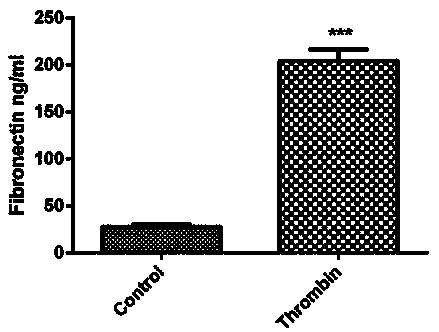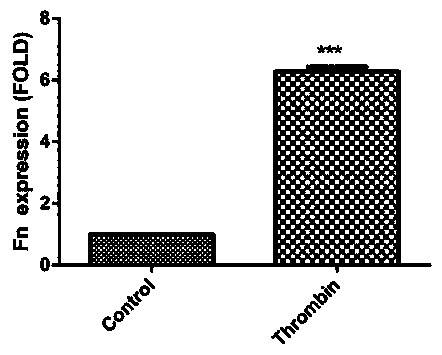Method applicable to serum-free culture of mesenchymal stem cells
A technology of serum-free culture and serum-free medium, which is applied in the biological field, can solve the problems of heavy workload, incomplete FN, and high price, and achieve good self-renewal dryness, maintain self-renewal dryness, and promote proliferating effect
- Summary
- Abstract
- Description
- Claims
- Application Information
AI Technical Summary
Problems solved by technology
Method used
Image
Examples
Embodiment 1
[0031] Example 1: Stimulating serum-free cultured bone marrow mesenchymal stem cells to secrete endogenous fibronectin
[0032] Steps:
[0033] 1) Bone marrow mesenchymal stem cells were divided into 5×10 4 Cells were seeded into 6-well plates.
[0034] 2) Add 2ml of medium 1 (control group, serum-free basal medium αMEM) and medium 2 (thrombin group, add thrombin 4 IU / ml to serum-free basal medium) respectively. 37°C, CO 2 The concentration was 5% for 24 h in a cell culture incubator.
[0035] 3) Collect the culture supernatant to measure the amount of fibronectin FN secreted by mesenchymal stem cells by ELISA method.
[0036] 4) The cells were collected to extract total cellular RNA, and real-time quantitative PCR was used to detect the expression of fibronectin mRNA in mesenchymal stem cells.
[0037] Results: After thrombin stimulation, the expression of fibronectin mRNA and the secretion of endogenous fibronectin in mesenchymal stem cells increased more than 6 times....
Embodiment 2
[0038] Example 2: Adhesion effect of serum-free cultured mesenchymal stem cells
[0039] Steps:
[0040] 1) Culture mesenchymal stem cells in medium 1 and (control group, serum-free basal medium αMEM) medium 2 (thrombin group, add thrombin 4 IU / ml to serum-free basal medium), 2×10 4 Cells were planted in 96-well plates and allowed to attach to the wall for 1 hour.
[0041] 2) Discard the medium and unattached cells.
[0042] 3) Wash 3 times with PBS to fully wash the unattached cells.
[0043] 4) Add MTT and incubate for 3-4h, discard MTT.
[0044] 5) Observe the number of cell adherence under a microscope.
[0045] 6) Add DMSO to dissolve adherent cells.
[0046] 7) Measure the absorbance value of the cells at a wavelength of 490nm to determine the cell adhesion.
[0047] Results: The number of adherent mesenchymal stem cells stimulated by thrombin group increased significantly in 1 h in serum-free culture. Such as image 3 As shown, the control group in the figure i...
Embodiment 3
[0048] Embodiment 3: The effect of thrombin group on the proliferation of mesenchymal stem cells in serum-free medium
[0049] Steps:
[0050] 1) Fully resuspend and mix the mesenchymal stem cells, and press 2×10 per well 3 The number of cells was planted in a 96-well plate, and medium 1 (control group, serum-free basal medium αMEM) and medium 2 (thrombin group, the concentration of thrombin added in the serum-free basal medium were divided into 0.25 and 0.5 respectively) , 1, 2, 4, 8, 10 IU / mL, 7 concentrations).
[0051] 2) 37°C, CO 2The concentration was 5% in the cell culture incubator for 3 days.
[0052] 3) Add CCK-8 and incubate for 3h.
[0053] 4) Measure the absorbance value of the cells at a wavelength of 450nm to determine the cell proliferation.
[0054] Results: This method can significantly stimulate the proliferation of mesenchymal stem cells in serum-free medium, and has a concentration-dependent effect, see Figure 4 .
PUM
 Login to View More
Login to View More Abstract
Description
Claims
Application Information
 Login to View More
Login to View More - R&D
- Intellectual Property
- Life Sciences
- Materials
- Tech Scout
- Unparalleled Data Quality
- Higher Quality Content
- 60% Fewer Hallucinations
Browse by: Latest US Patents, China's latest patents, Technical Efficacy Thesaurus, Application Domain, Technology Topic, Popular Technical Reports.
© 2025 PatSnap. All rights reserved.Legal|Privacy policy|Modern Slavery Act Transparency Statement|Sitemap|About US| Contact US: help@patsnap.com



